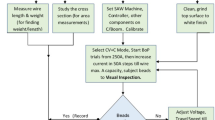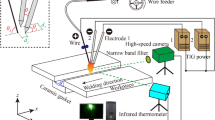Abstract
The present paper deals with a shop floor applicable mathematical model for deposition rate during twin-wire submerged arc welding. The salient features of this model are (1) instead of melting rate, as modeled during past investigations, it quantifies the deposition rate, which is the actual outcome of the process and always remains smaller than the melting rate because of evaporation or spatters losses and (2) it estimates electrode extension in order to predict the deposition rate which makes the proposed model more practical than the models constituted with the help of experimental measurement of electrode extension. The model is more scientific than the simplified models where contact tube to work-piece distance has been considered as the electrode extension. A critical review of the relevant past investigation is given and a mathematical model is developed for deposition rate during the twin-wire welding with both the polarities, i.e., direct current electrode positive and direct current electrode negative. The model is calibrated using the results of 200 experimental runs and it is found to be very accurate with very high coefficient of regression and admissible standard error. The developed model is further validated with extra experimental runs. The practicality of the considered approach for prediction of deposition rate can further be used in future research for other consumable arc welding processes.
Similar content being viewed by others
References
Wilson JL, Clauseen GE, Jackson CE (1956) The effect of I2R heating on electrode melting rate. Weld J 35(1):1s–8s
Robinson MH (1961) Observation on melting rate during submerged arc welding. Weld J 40(11):503s–515s
Lesnewich A (1958) Control of melting rate and metal transfer in gas-shielded metal-arc welding part 1 - control of electrode melting rate. Weld J 37(8):343s–353s
Yang LJ, Bibby MJ, Chandel RS (1993) Linear regression equations for modeling the submerged-arc welding process. J Mat Proc Technol 39:33–42
Yang LJ, Chandel RS, Bibby MJ (1993) An analysis of curvilinear regression equations for modeling the submerged-arc welding process. J Mat Proc Technol 37:601–611
Chandel RS (1987) Mathematical modeling of melting rates for submerged arc welding. Weld J 66(5):135s–140s
Tušek J (2000) Mathematical modeling of melting rate in twin-wire welding. J Mat Proc Technol 100:205–256
Nemchinsky VA (1998) The rate of melting of the electrode during arc welding. The influence of discrete removal of the melt. J Phys D Appl Phys 31:1565–1569
Nemchinsky VA (1998) Electrode melting during arc welding with pulsed current. J Phys D Appl Phys 31:2797–2802
Tušek J (1999) A mathematical model for the melting rate in welding with a multiple-wire electrode. J Phys D Appl Phys 32:1739–1744
Hinkel JE, Frosthoefel FE (1976) High current density submerged arc welding with twin electrodes. Weld J 55(3):175–180
Asthon T (1954) Twin wire submerged arc welding. Weld J 33(4):350–355
Mandel Berg SL, Lopata VE (1966) The high speed twin electrode SAW process. Weld Prod 2:25–28
Uttrachi GD (1978) Multiple electrode system of SAW. Weld J 57(5):15–22
Shchetinina VI, Leshchinski LK, Serenko AN (1981) Submerged arc welding with combined electrode. Weld Prod 9:13–14
Tusek J, Umek I, Bajcer B (2005) Weld-cost saving accomplished by replacingsingle-wire submerged arc welding with triple-wire welding. Sci Technol Weld Join 10(1):15–22
Lesnewich A (1987) Commentary: mathematical modeling of melting rates for submerged arc welding. Weld J 68(12):386s–388s
Jeff Wu CF, Hamada M (2002) Experiments planning analysis and parameter design optimization, 1st edn. Wiley, Singapore
Douglas C (2004) Montgomery, design and analysis of experiments, 5th edn. Wiley, Singapore
Coit DW, Jackson BT, Smith AE (1998) Static neural network process models: considerations and case studies. Int J Prod Res 36(11):2953–2967
Kim DH, Kim DJ, Kim BM (1999) The application of neural networks and statistical methods to process design in metal forming processes. Int J Adv Manuf Technol 15:886–894
Wasznik JH, van den Heuvel GJPM (1982) Heat generation and heat flow in the filler metal in GMA welding. Weld J 61(8):269s–282s
Metropolis N, Rosenbluth A, Rosenbluth M, Teller A, Teller E (1953) Equation of state calculation by fast computing machines. J Chem Phys 21:1087–1092
Kirkpatrick S, Gelatt CD, Vecchi MP (1983) Optimization by simulated annealing. Science 220(4958):671–680
Jackson CE, Shrubsall AE (1950) Energy distribution in electric welding. Weld J 29(5):231s–241s
Author information
Authors and Affiliations
Corresponding author
Rights and permissions
About this article
Cite this article
Sharma, A., Arora, N. & Mishra, B.K. A practical approach towards mathematical modeling of deposition rate during twin-wire submerged arc welding. Int J Adv Manuf Technol 36, 463–474 (2008). https://doi.org/10.1007/s00170-006-0847-1
Received:
Accepted:
Published:
Issue Date:
DOI: https://doi.org/10.1007/s00170-006-0847-1




